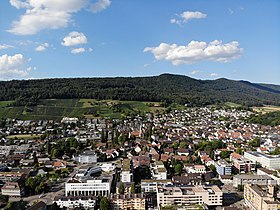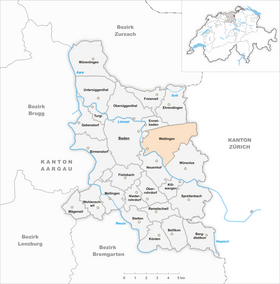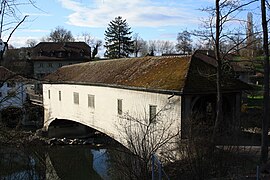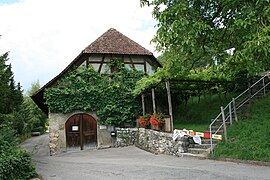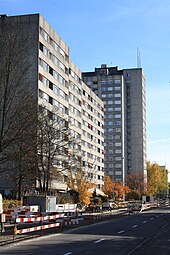Wettingen
| Wettingen | |
|---|---|
| State : |
|
| Canton : |
|
| District : | to bathe |
| BFS no. : | 4045 |
| Postal code : | 5430 |
| UN / LOCODE : | CH WTG |
| Coordinates : | 666 953 / 257 610 |
| Height : | 395 m above sea level M. |
| Height range : | 357–859 m above sea level M. |
| Area : | 10.60 km² |
| Residents: | 20,960 (December 31, 2019) |
| Population density : | 1977 inhabitants per km² |
|
Proportion of foreigners : (residents without citizenship ) |
27.9% (December 31, 2019) |
| Website: | www.wettingen.ch |
|
View of the village center and the warehouses |
|
| Location of the municipality | |
Wettingen ( Swiss German ˈʋɛtːiɡə ) is a municipality in the Swiss canton of Aargau . It belongs to the Baden district , is located in the central Limmat Valley and borders directly on the district capital of Baden . With over 20,000 inhabitants, Wettingen is the second most populous municipality in Aargau.
geography
Wettingen is located on the right bank of the Limmat , directly in front of the Klus von Baden . Most of the settlement area is covered by the Wettingerfeld, a flat gravel plain surrounded on all sides by natural boundaries: in the west and south by the river, in the north by the steep southern slope of the Lägern ( 859 m above sea level ) belonging to the Folded Jura and in the East of Sulperg ( 569 m above sea level ). The Eigital, which is not built over, is located between the Lägern and the Sulperg. At its western end, in the northeast of the Wettingerfeld, is the old, still relatively well-preserved village center. The southern slope of the Lägern is partially planted with vines (see also viticulture in Wettingen ). The Dorfbach crosses the Wettingerfeld and finally flows over the Gottesgraben into the Limmat. It is partly canalised, partly tunneled and partly renatured.
The area of the municipality is 1060 hectares , of which 406 hectares are forested and 423 hectares are built over. The highest point is at 859 meters on the Burghorn (part of the Lägern), the lowest at 360 meters on the Limmat. Neighboring communities are Ennetbaden in the northwest, Ehrendingen in the north, Niederweningen in the northeast, Otelfingen in the east, Würenlos in the southeast, Neuenhof in the south and Baden in the west.
history
Two graves from the Neolithic Age were found in the municipality of Wettingens . At the time of the Romans there was a small settlement here. The Roman road ran through the Wettinger Feld from Vindonissa ( Windisch ) via Aquae Helveticae ( Baden ) to Vitudurum ( Oberwinterthur ). The only remnant of a temple of Isis that has survived is an inscription, which is now walled into the Catholic Church of St. Sebastian. The first Alemannic settlers settled in the course of the first wave of settlement in the 6th century at the site of the abandoned Roman settlement.
Wettingun was first mentioned in a document in 1045. The place name comes from Old High German and means "among the people of Wetti". From this time the different form Wattingun is known, which refers to the "people of Watto". Christianity found its way into Wettingen in the early Middle Ages. The first churches were founded by private individuals, so-called collators . In return, they could claim tithe for themselves. Wettingen belonged to the early Thurgau for a long time and when it was divided it became part of the Zürichgau . In 1173 the Counts of Lenzburg died out and their territories came into the possession of the Counts of Kyburg .
Baron Heinrich II von Rapperswil bought goods in Wettingen after 1220 and the right of patronage for the village church. After Heinrich was miraculously rescued from distress at sea during the crusades , he donated his possessions in Wettingen to the Salem abbey . This sent monks to Wettingen to found a new abbey in a loop of the river Limmat. October 14, 1227 is considered the founding date of Wettingen Monastery , which subsequently rose to become the most important landlord in the region and also exercised lower jurisdiction from the 14th century .
When the Kyburg dynasty died out, their possessions passed to the Habsburgs in 1273 . In 1415 the Swiss conquered Aargau and Wettingen was now the capital of the office of the same name in the County of Baden , a common rule . During the Reformation , from August 7, 1529, first the village pastor Jakob Leu confessed to the new denominations, one day later the abbot Georg Müller with the majority of the monks at the time. The majority of the village population also converted, but - like the monastery - was re-Catholicized after the Second Kappel War of 1531. In 1633 a Roman silver treasure with eight vessels and numerous coins from the 3rd century came to light near the monastery. The delegates of the Diet in Baden divided the treasure among themselves, but the Zurich gentleman H. Witz had the finds recorded before they were melted down.
During the Second Villmerger War of 1712, the village was occupied by troops from Zurich and Bern, who shot at the Stein fortress in Baden from Wettingerfeld . In March 1798 the French took Switzerland and proclaimed the Helvetic Republic . Wettingen was initially a municipality in the short-lived canton of Baden . In this and the following year French, Austrian and Russian troops marched through the village one after the other and held themselves harmless at the expense of the residents. The community has belonged to the canton of Aargau since 1803.
In the course of the Aargau monastery dispute, the Grand Council decided on January 13, 1841 to close all Aargau monasteries, including the Wettingen monastery. The monks were given 48 hours to leave the monastery and finally moved into the remains of the old Benedictine monastery Mehrerau in Bregenz on June 8, 1854 (today the Territorial Abbey of Wettingen-Mehrerau ). All monastery goods passed into state ownership and the extensive holdings of the monastery library were transferred to the cantonal library in Aarau .
Wettingen was now a farming village with the Wettingen teachers' college opened in 1847 in the premises of the former monastery. The first railway line in Switzerland, the Spanish Brötli Railway , began operating on August 9, 1847. At first, however, it led along the left bank of the Limmat, on the other side of the river. In 1858 a spinning mill was built next to the former monastery. At the request of the factory owner, the Swiss Northeast Railway moved the route in this section to the right side of the Limmat and Wettingen was given a train station in 1876 in a central location between the monastery district and the village. The opening of the national railway to Zofingen was on September 6, 1877, the section to Winterthur followed a few weeks later on October 15. To compete with this, the Bülach-Baden-Bahn was opened on October 1st of the same year ; However, this was shut down on January 18, 1937.
After the BBC was founded in neighboring Baden in 1891 , which subsequently expanded rapidly, Wettingen quickly became a working-class suburb. Due to its unfavorable topographical location, Baden itself had little space for new settlements and so many BBC workers moved to Wettingen, which still had extensive building land reserves in the flat Wettingerfeld. The population structure changed permanently due to the immigration over decades. In addition to the Catholic village population, many Reformed people came to Wettingen, as did Catholics from other regions of Switzerland and later also from abroad. This led to the construction of the reformed church in Wettingen (1939) and the Roman Catholic parish church of St. Anton (1954) as well as the establishment of a parish of the same name. The Wettingen electricity and waterworks were founded in 1938 . In 1939, the BBC commissioned an experimental facility for direct current high-voltage transmission from the Wettingen power station to Zurich .
Wettingen had already grown together with Baden in the first half of the 20th century. The village experienced a renewed growth surge between 1950 and 1960, when the number of inhabitants increased by over two thirds and the last free areas in the middle of the Wettingerfeld were built over. In 1967 the number of inhabitants reached its provisional high of 20,019. It fell by almost twelve percent by 1990, but then stabilized at around 18,000 and rose again to over 20,000 in 2010. In 1973 the new cemetery and the Brunnenwiese cemetery church were inaugurated, and in 1974 the large sports and recreation center Tägerhard was opened, which, with its diverse range, gained national importance.
Attractions
The monastery Wettingen , a former Cistercian monastery in a bend in the river Limmat, is the most important in terms of cultural history . The Wettingen Cantonal School is housed in the monastery buildings today . You can visit the early Gothic Maria Meerstern monastery church with its baroque Renaissance choir stalls and the cloister with the Wettinger baby Jesus . Other church buildings are also worth seeing: the late Baroque Marienkapelle with Stations of the Cross on the Sulperg, the high Baroque Kreuzkapelle at the exit towards Würenlos and the catholic parish church of St. Sebastian built in the style of historicism with Art Nouveau echoes , in the entrance area of which a Roman inscription from an Isis temple is walled. The Catholic parish church of St. Anton , a concrete hall church with picture tapestries, is an example of modern church construction in the 1950s.
The importance of Wettingen as a vineyard is evident in the Rote Trotte on Rebbergstrasse, which is a listed building and is still in use today as a Trotte. An example of modern architecture is the district school building, an early work by the architect Theo Hotz , which, however, had to be rebuilt in the 1970s due to significant structural defects. Also worth seeing are the Limmat cultural path with numerous contemporary sculptures, the Wettingen-Windisch industrial culture path and the Wettingen-Neuenhof wooden bridge . The Walhalla is a small cave that was carved out of a crevice in the 20th century. Wettingen also offers a number of hiking trails.
coat of arms
The blazon of the municipal coat of arms reads: "In the wave cut divided by red with a six-pointed yellow star, and by white with three blue waves." The first coat of arms depicted on the seal from 1827 shows Saint Sebastian tied to a tree and hit by arrows . A few years later it was replaced by a coat of arms showing a star over a wavy surface of water. The form that is valid today, which corresponds to the coat of arms of the Wettingen monastery and was shown on the map of the canton of Zurich in 1667, was introduced in 1957.
population
The population developed as follows:
| year | 1798 | 1850 | 1900 | 1930 | 1950 | 1960 | 1970 | 1980 | 1990 | 2000 | 2010 |
| Residents | 721 | 1610 | 3128 | 8505 | 11,667 | 17,613 | 19,900 | 18,377 | 17,706 | 17'870 | 20,134 |
On December 31, 2019, 20,960 people lived in Wettingen, the proportion of foreigners was 27.9%. In the 2015 census, 40.3% described themselves as Roman Catholic and 17.8% as Reformed ; 41.9% were non-denominational or of other faiths. 84.2% stated German as their main language in the 2000 census , 5.1% Italian , 2.3% Serbo-Croatian , 1.1% Spanish , 1.0% Albanian and French , 0.8% each English and Portuguese and 0.6% Turkish .
Politics and law
legislative branch
Since 1966, instead of the usual community assembly in smaller communities, the community parliament, the residents ' council, elected by the Wettinger voters , has represented the concerns of the population. It consists of 50 members who are each elected for four years by proportional representation. He is responsible for approving the tax rate , the budget, the annual accounts, the annual report and the loans. He also issues regulations and controls the administration of the executive branch. The residents' councils can submit parliamentary proposals ( motion , postulate , small questions ).
The graphic on the right shows the distribution of seats after the election on September 24, 2017. In the last five elections, the parties achieved the following number of seats:
| Political party | 2001 | 2005 | 2009 | 2013 | 2017 |
|---|---|---|---|---|---|
| CVP | 14th | 15th | 14th | 12 | 12 |
| SVP | 10 | 10 | 12 | 12 | 11 |
| SP | 9 | 10 | 8th | 9 | 9 |
| FDP | 7th | 7th | 7th | 7th | 7th |
| EPP | 4th | 3 | 3 | 3 | 3 |
| Wet green | 2 | 3 | 3 | 3 | 2 |
| glp | 2 | 4th | |||
| Forum 5430 | 3 | 2 | 2 | 1 | 2 |
| BDP | 1 | 1 | |||
| SD | 1 |
Various elements of direct democracy can also be found at the level of the resident community . The population is entitled to optional and compulsory referendums as well as the popular initiative .
executive
The executing authority is the seven-member municipal council . He is elected by the people for four years in a majority process . The municipal council leads and represents the community of residents. To this end, it implements the resolutions of the residents' council and the tasks assigned to it by the canton. As head of the executive practicing mayor from its activities in full office, the other local councils in the next Office (see also the council representatives of Wettingen list ).
The seven municipal councils for the 2018–2021 term are:
- Roland Kuster (CVP), mayor
- Markus Maibach (SP), Vice-Minister
- Martin Egloff (FDP)
- Kirsten Ernst (SP)
- Markus Haas (FDP)
- Philippe Rey (independent)
- Sandro Sozzi (CVP)
Judiciary
The Baden District Court is responsible for litigation in the first instance . Wettingen is the seat of Friedensrichterkreis IV, which comprises six communities in the east of the district.
National elections
In the 2019 Swiss parliamentary elections, the share of the vote in Wettingen was: SVP 22.4%, SP 19.1%, CVP 13.6%, FDP 12.1%, glp 11.5%, Greens 10.8%, EPP 5.4 %, BDP 2.3%, team 65+ 1.1%.
economy
According to the company structure statistics (STATENT) collected in 2015, Wettingen has around 8,600 jobs, of which 1% in agriculture, 24% in industry and 75% in the service sector. 23 agricultural companies, 180 industrial companies and 1,093 service companies were registered. There are no large corporations in Wettingen, but there are a large number of small and medium-sized enterprises ( SMEs ). The community had about the same number of commuters as it did inbound. Many employees work in Baden , in the Limmattal or in Zurich . The electricity company of the City of Zurich (EWZ) operates a run-of-river power plant, which includes a 29-meter high gravity dam on the Limmat between Wettingen and Neuenhof (see Wettingen reservoir ). The Jazztime magazine publisher is located in the village .
traffic
The A1 motorway runs south of the municipality . Wettingen can be easily reached from two motorway connections, the Wettingen-Ost exit and the Neuenhof exit. Important main roads lead from Wettingen through the Limmattal and the Furttal. The first roundabout in the canton of Aargau was inaugurated in 1987 at the town hall in Wettingen . The most important inner-city road is the country road , the course of which corresponds to the canton road 295.
The station Wettingen is formed by two lines of the S-Bahn Zurich served. The S6 runs through the Furttal , the S12 through the Limmattal and then on to Baden or Brugg . Other direct connections lead via Aarau to Olten and at rush hour through the lower Aare valley to Koblenz . The railway line to Lenzburg was closed to passenger traffic on December 12, 2004. The next train station with an express train stop is Baden. The regional transport company Baden-Wettingen (RVBW) operates a dense network of bus routes in Wettingen, Baden and ten other communities in the area; six lines open up the municipal area of Wettinger.
On weekends, there is a night S-Bahn line ( Winterthur - Zurich HB –Baden– Brugg –Lenzburg – Aarau) and night bus lines from Baden train station to Dietikon and Würenlos .
education
The community operates 18 kindergartens and one language therapy kindergarten. The primary school is organized in four schools with five school buildings: Altenburg, Margeläcker and Dorf (the latter with the Sulperg and Lägern locations) for the 1st to 4th graders and the Zehntenhof schoolhouse for the 5th and 6th graders. The Real and Secondary School are combined to form Sereal and are located in the Margeläcker school building. The district school is located on Alberich-Zwyssig-Strasse opposite the town hall. The Wettingen Cantonal School , which works closely with the Baden Cantonal School, has been housed in the buildings of the former monastery since 1976 . Other schools of importance are the special education school and the adult education center founded in 1962 .
sports clubs
- FC Wettingen
- FC Juventina Wettingen
- HC Rotweiss Wettingen
- Wettingen Wild Lacrosse
- LV Wettingen-Baden
- Badminton Club Wettingen
- SV Lägern
- Wettingen tennis club
Personalities
Honorary citizen
- Josef Koch , pastor (1874)
- Julius Waldesbühl , pastor (1918)
- Lothar Hess , Mayor (1993)
- Toni Businger (1934–2019), stage and costume designer (2005)
- Markus Dieth (* 1967) politician, honorary citizen of the local community (2016)
Born in Wettingen
- Karl Attenhofer (1837–1914), music director
- Traugott Sandmeyer (1854–1922), chemist
- Rufin Steimer (1866–1928), Capuchin preacher and first President of the Swiss Caritas
- Alfred Wyrsch (1872–1924), politician
- Eduard Spörri (1901–1995), sculptor
- Walter Huser (1903–1981), sculptor
- Ernst Haller (1910–1986), politician
- Gustav Meier (1929–2016), conductor and music teacher
- Anton Egloff (* 1933), sculptor
- Toni Businger (1934–2019), freelance stage and costume designer
- Christian Müller (* 1944), journalist
- Ruedi Sommerhalder (* 1947), sculptor
- Rainer Klausmann (* 1949), cameraman
- Ruedi Meier (* 1949), economist, spatial planner and energy specialist
- Fritz Huser (* 1952), painter and illustrator
- Herbert Bolliger (* 1953), manager
- Urs Blöchlinger (1954–1995), jazz musician
- Eric Hattan (* 1955), concept, video, performance and installation artist
- Bernhard M. Hämmerli (* 1958), computer scientist
- Eva Scheurer (* 1958), actress
- Ingrid Deltenre (* 1960), manager
- Bruno Meier (* 1962), historian and publisher
- Markus Somm (* 1965), journalist
- Tobias Straumann (* 1966), economic historian
- Monika Schärer (* 1968), television and radio presenter
- José Maria Larocca (* 1969), Argentine show jumper
- Patrick von Castelberg (* 1973), tenor
- Patrick Bannwart (* 1974), stage and costume designer and video designer
- Lilian Studer (* 1977), politician
- Andreas Camenzind (* 1982), ice hockey player
Other personalities
- Johann Daniel Elster (1796–1857), German music professor and choir director
- Alberich Zwyssig (1808–1854), composer of the Swiss national anthem
- Hans Schmid (1879–1911), pilot
- Karl Grenacher (1907–1989), music teacher, music director at the Wettingen teacher training college
- Ilse Weber (1908–1984), painter and draftsman
- Max Voegeli (1921–1985), writer
- Fritz Senft (1922–1997), writer
- Elisabeth Schmid (1923–2014), politician and first President of the Aargau Grand Council
- Max Knecht (1929–2016), politician
- Henning Paur (* 1943), German jazz musician and surgeon
- Heiner Studer (* 1949), politician
- Doris Stump (* 1950), politician
- Werner Hartmann (* 1953), computer science educator
- Margrit Wahrstätter (* 1954), politician and first and so far only president of the residents' council
- Antoinette Eckert (* 1956), politician
- Bernhard Müller , (* 1957) Commander of the Swiss Air Force
- Roland Kuster (* 1959), politician
- Thomas Bodmer (* 1960), politician
- Antoinette Hunziker (* 1960), entrepreneur and banking specialist
- Monica Cantieni (* 1965), writer
- Yvonne Feri (* 1966), politician
- Lutz Fischer-Lamprecht (* 1967), politician
- Jörg Stiel (* 1968), soccer goalkeeper
- Karin Suter-Erath (* 1970), disabled athlete
- Daniel Notter (* 1972), politician
- Lea Schmidmeister (* 1983), politician
- Michaela Huser (* 1987), politician
See also
literature
- Bruno Meier : Wettingen. In: Historical Lexicon of Switzerland .
- Peter Hoegger: The art monuments of the canton of Aargau . Ed .: Society for Swiss Art History . Volume VII: District of Baden II. Birkhäuser Verlag, Basel 1995, ISBN 3-909164-44-7 , p. 182-225 .
- Return, Ruth: One parish, two parishes. Catholic Church History Wettingen. Wettingen 2017.
Web links
Individual evidence
- ↑ Cantonal population statistics 2019. Department of Finance and Resources, Statistics Aargau, March 30, 2020, accessed on April 2, 2019 .
- ↑ Cantonal population statistics 2019. Department of Finance and Resources, Statistics Aargau, March 30, 2020, accessed on April 2, 2019 .
- ↑ a b Beat Zehnder: The community names of the canton of Aargau . In: Historical Society of the Canton of Aargau (Ed.): Argovia . tape 100 . Verlag Sauerländer, Aarau 1991, ISBN 3-7941-3122-3 , p. 459-460 .
- ^ National map of Switzerland, sheet 1070, Swisstopo.
- ↑ Standard area statistics - municipalities according to 4 main areas. Federal Statistical Office , November 26, 2018, accessed on June 6, 2019 .
- ↑ Lutz Fischer-Lamprecht: A rocky road. On the construction of the reformed church in Wettingen in 1938/39 up to the inauguration of the organ in 1941. In: Badener Neujahrsblätter 2015, p. 148.
- ^ Martin Hartmann, Hans Weber: The Romans in Aargau . Verlag Sauerländer, Aarau 1985, ISBN 3-7941-2539-8 , p. 206 .
- ↑ Not just for heroes: Wettinger hikers also get to Walhalla. Aargauer Zeitung , June 21, 2011, accessed on June 15, 2013 .
- ^ Joseph Galliker, Marcel Giger: Municipal coat of arms of the Canton of Aargau . Lehrmittelverlag des Kantons Aargau, book 2004, ISBN 3-906738-07-8 , p. 312 .
- ↑ Population development in the communes of the Canton of Aargau since 1850. (Excel) (No longer available online.) In: Eidg. Volkszählung 2000. Statistics Aargau, 2001, archived from the original on October 8, 2018 ; accessed on June 6, 2019 .
- ↑ Resident population by religious affiliation, 2015. (Excel) In: Population and Households, Community Tables 2015. Statistics Aargau, accessed on June 6, 2019 .
- ↑ Swiss Federal Census 2000: Economic resident population by main language as well as by districts and municipalities. (Excel) (No longer available online.) Statistics Aargau, archived from the original on August 10, 2018 ; accessed on June 6, 2019 .
- ↑ Minutes on the election of 50 members of the Wettingen community council for the 2014/2017 term of office. (PDF; 82 kB) Wettingen municipality, September 22, 2013, accessed on September 24, 2013 .
- ↑ Minutes of the general renewal elections of the residents' council 2018/2021. (PDF; 156 kB) City of Wettingen, September 24, 2017, accessed on September 26, 2017 .
- ↑ circles of justice of the peace. Canton of Aargau, accessed on June 18, 2019 .
- ^ Federal Statistical Office : NR - Results parties (municipalities) (INT1). In: Federal Elections 2019 | opendata.swiss. August 8, 2019, accessed August 1, 2020 .
- ↑ Results of the National Council elections 2019 - Canton Aargau. Retrieved August 2, 2020 .
- ↑ Statistics of the corporate structure (STATENT). (Excel; 157 kB) Statistics Aargau, 2016, accessed on June 6, 2019 .
- ↑ Canton celebrated its 100th canton road roundabout. fricktal24.ch, November 9, 2007, accessed on January 22, 2010 .
- ↑ Aargauer Zeitung of August 6, 2009, Baden regional section, p. 5.
- ^ Minutes of the Wettingen municipal council meeting on March 10, 2005

